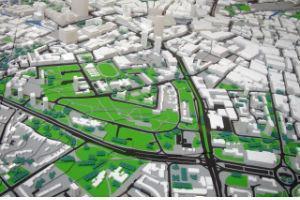 The analysis of the data produced by a BIM (Building Information Modeling) system can generate a positive impact on the field of Facility Management during the exploitation phase of a physical asset.
The analysis of the data produced by a BIM (Building Information Modeling) system can generate a positive impact on the field of Facility Management during the exploitation phase of a physical asset.
By Jordi Sánchez Castilla*
In the exploitation of a physical real estate asset, whether for administrative or industrial use, a high amount of information is required, in addition to good management and use of it to operate it in a reliable, sustainable and profitable way.
Information such as, for example, the updated plans during the life cycle of the physical asset when proceeding to a reform of an existing space and / or installation, an extension or significant reduction of the asset. In addition, digitized systems that allow quick access to the information required at all times in relation to aspects such as:
- Space management.
- In case of leases, contractual information of the same.
- Operation and maintenance manuals (preventive maintenance) of the
buildings and other constructive elements.
- Updated regulations applicable to the construction elements and activity that make up the physical asset.
- Documentation relating to the duration and expiration of guarantees.
- Documentation related to information on safety, hygiene and environment that produces the activity in the property, as well as the material that makes up it.
- Monitoring and updating programs for predictive and corrective maintenance.
- Surveys and results of the perception of tenants/users/clients/owners in relation to their activity in the property.
All the above and others according to the specificity of the asset and the organization, properly managed, allows to maintain the value of the asset both at an operational and financial level in profitability parameters beneficial to the owner of the same, in case in the future the asset is sold, if you want to operate in the most efficient way possible and respectful of the environment, you want to attract tenants with a higher degree of demand in their activity, you seek to be certified with a prestigious body, or in case you want the organization to be as competitive as possible within your market.
Common problems in the exploitation phase
In relation to the achievement of the above points, there are some quite widespread problems that hinder the above, which are the following:
- O&M personnel (operation and maintenance) do not have enough time to update the status of the asset in relation to reforms, corrective-preventive, extensions and reductions.
- Partial inaccessibility to original documentation of the asset once the construction phase is finished, which produces inefficiencies in the maintenance management of the asset.
- Facilities maintenance programs based solely throughout the life cycle of the asset on the initial recommendations of the manufacturers, and not based on the operation and activity of the organization.
- In many cases, there are no predictive maintenance programs such as RCM, RCFA, TPM for key elements in the operation of the asset, more oriented in this case to industrial processes, or if they exist, they are not executed satisfactorily in their entirety.
- There is no adequate alignment between the maintenance operations of the asset and the need and expectations of the organization in relation to its activity.
- There is no good analysis in the management of the risk caused by the activity of the organization in relation to O&M plans.
- Not having updated and accurate information in relation to spaces, for analysis of space management, lease negotiation, productivity studies in the work environment.
- Lack of fluid communication and transversal collaboration between departments such as O&M, IT, HR. HH, purchasing and finance.
Benefits of trading with BIM
Some of the potential advantages for asset owners are as follows:
- Have an updated database of the physical elements, which are a reliable source for decision-making in relation to the sale; reform, renegotiation with tenants, modification of the productive system, activity of the organization, among others.
It also offers cost control in relation to:
- The most appropriate maintenance program to be carried out in the facilities / constructive elements according to the activity of the organization and use of the asset.
- Reforms and management of spaces in search of improving the productivity of personnel and processes.
- Updated control at the financial level of the residual value of the asset, through the scheduled amortizations and the real use-wear of the facilities and their constructive envelope.
- Quick responses to the demands that the organization and / or regulatory entity may demand thanks to the available, reliable and updated information, in relation to preparing constructive budgets for the growth or decrease of the asset, safety and health, risk analysis, correctives, etc.
- Less dependence on existing operational-maintenance personnel, since the know-how will be available to the organization through the BIM-CMMS-CAFM platforms.
- Reduction in cost of services (energy-water) due to lower consumption for the same activity by having the facilities managed and working correctly due to an adequate preventive and predictive maintenance program, fully updated and analyzed.
- Reduction of repairs and corrections that limits the impact on the activity of the organization.
- Reduction of waiting times for repairs.
- Improvement in the inventory management of components and supplies for each component listed in the program. This can give a negotiating advantage in the purchasing process and reduce stock costs.
- Increase in the life cycle of the assets, which will have an impact on a lower CAPEX and OPEX in relation to if you do not have an adequate physical asset management program supported by a tool such as updated BIM.
- Sustainability of the asset, for example, by knowing what materials the building is composed of, in case any of them deteriorates or that by regulations is considered dangerous in the future, its location and quantity to be replaced can quickly be located, in addition to being able to have more information for example for the calculation of the carbon footprint of the building.
- Analysis of the existing spaces with the real activity in them, which will allow the analysis of different solutions in lay-outs in search of the maximum productivity of the personnel and the processes, obtaining quite immediately the impact that they could suppose at the level of costs.
- Ease of obtaining data for possible audits aimed at different purposes, such as regulatory in O&M, or a purchase-sale.
Benefits for FM staff
- Easier and faster accessibility to the information produced in the design and construction phase, which will result in an improvement in the response time (less time consumed by each corrective work order to execute the task) and in the efficiency of the services to be performed by the FM department.
- Use of a program where interoperability is integrated and seen between various systems (such as HVAC, fire system, electrical installation, fluid installation, etc.), with the space where they are present, as well as the personnel and / or the productive equipment located in those spaces. This produces a simulation of the actual operation of the asset and helps to program the most appropriate O&M- Space Management- IT-HR plans at each moment of the asset life cycle.
- Have at your disposal a system that helps to have a follow-up of the guarantees of the properties / constructive elements, warning when they are going to expire, in order to be able to carry out an inspection of them, and in case of any irregularity covered by the guarantee, to be able to claim their correction at the cost of the supplier / manufacturer.
- Have a system that issues warnings in case of rupture / habitual breakdown of any equipment, this with history that contains the photograph of the equipment, significant actions carried out on it, original documentation of the manufacturer, etc. This will allow you to adjust O&M programs as efficiently as possible.
- Possibility of having a system in which you can visualize cutting sections in 3D, which allows you to visualize when necessary that it passes through the interior of an electrical conduit, fluids, thickness of the duct, material, etc ... that helps the rapid analysis of the element and an adequate action, saving a lot of time of intervention of the maintenance personnel and possible affectations to the activity of the organization.
- BIM through a visualization program, allows the augmented reality type supervision of the facilities and spaces remotely, being able to select equipment, analyze its current state of operation and consult the information related to it (manuals, guarantees, work orders, preventive or predictive maintenance plan, etc.), allowing to save action times by FM staff and having a positive impact on the activity of the organization. It is a function that also if several centers are managed has even more positive impact.
- Possibility with the augmented reality visualizer, to have updated information to the act allowing a faster and more efficient decision making.
Conclusions
An adequate management of the life cycle of physical assets must be supported by a good integration and interoperability between various agents such as:
- Updated information available at all times of the asset.
- Alignment between the objectives and activity of the organization with O&M plans
Existing.
- Existence of an organizational policy in relation to the management of physical assets.
- Computer tools that support the management of the asset and that the information
that produce is analyzed and updated efficiently.
BIM in the exploitation phase helps and supports all of the above, since it allows better decision making through the analysis of the real and updated information that the asset and its activity is producing at all times.
Translating this into an improvement in the performance of the asset and the activity of the organization, shown through indicators such as sales per unit of productive cost; ROI/VAN of the asset, OEE (Overall Equipment Effectiveness), cost per square meter of occupancy, among others.
* Jordi Sánchez Castilla is the Director of S&V Consulting, a consulting company specialized in the fields of Facilities, Asset and Property Management.


























Leave your comment